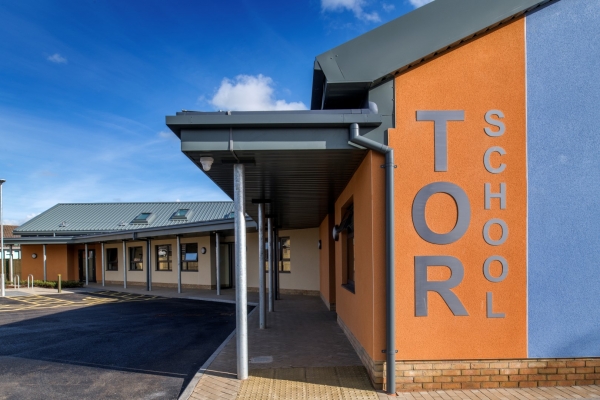Project Details
Client
Somerset County Council
Project Manager
Somerset County Council
Architect
NVB Architects
Contractor
Midas Construction Ltd
Value
£2.9m
Contract Period
47 weeks
Procurement Type
Competitive tender – 2 stage
Form of Contract
NEC3 Option A
Size
830m²
Apprentices
6
Project summary
Tor School is a Pupil Referral Unit (PRU) in Glastonbury, one of the first fully integrated PRUs in the UK, which brings together three streams of Somerset County Council’s educational facilities. The school offers alternative educational provision for vulnerable young people who struggle in a mainstream school environment and provides facilities for Key Stages 2, 3 and 4. The PRU includes a Learning Enhancement Centre with facilities for outreach staff. Designed with the needs of the young people in mind, the building’s layout enables direct access from each classroom to dedicated external spaces. The different year groups share specialist spaces, including a breakout room with low-level lighting.
Midas constructed this single-storey, 12 classroom educational building on a design and build contract. This well-insulated building features blockwork render on all elevations with a truss timber roof and robust internal fittings designed to accommodate the specialist needs of the pupils. Midas completed groundworks including drainage and service connections, with internal works including first fix M&E, dry lining, plastering and decorations.
The client scored the project 100% in the customer satisfaction survey at practical completion and the site received a CCS Bronze 2018 National Site Award.
“We were previously a number of different centres that were brought together as one school and in February 2018 we moved into new premises. This is one of the first fully integrated PRUs in the country. As such we try to avoid labelling young people in simplistic ways and we put the needs of the child at the centre of the learning plan we develop.”
Community Engagement
Career Opportunities
- Six apprenticeships provided through the project
Key Challenges
The client had a restricted budget with which to meet their project requirements
- Midas completed a best value review with the client early in the preconstruction process to offer a £566k cost reduction at Gateway 3, with £676k delivered at Gateway 4 including changing the render specification, changing the external paving to tarmac and rationalising the footpaths. Midas saved the client £20k by recommending metal soffits as an alternative product with an improved lifespan and by building for longevity by using hardwood doorframes and achieving an air tightness rating of 3.6m³/hm² (below the target of 5m³/hm²).
This constrained site contained a party wall and was bounded by commercial and residential properties, including a live ambulance station to the south and an adjacent Learning Difficulties Day Centre that remained open throughout the project.
- The team secured the site with Heras fencing, hoarding, signage and gate control, and liaised regularly with the client team and key stakeholders of the Day Centre. To manage the restricted space, Midas negotiated use of an adjacent unpaved area between the site and the ambulance station, used for ambulance parking. Midas created a hard-standing area shared between the ambulance service and the site team during the project, providing them with a finished car park at completion of works. Midas maintained open communication with their staff holding regular update meetings to maintain this amicable relationship.
The site contained hazardous underground and overhead live services including a high voltage (HV) cable that served half of Glastonbury. The project also included creation of a substation requiring rerouting of existing services and removal of redundant services.
- To manage the significant risk to operatives and the public presented by the live services, Midas commissioned a Utility Report and ground scans to provide an overlay of the site footprint and services. The team completed additional service locating procedures prior to breaking ground, with a subsurface scan of the entire site. Midas ensured operatives completed works under a permit to dig system, using site service drawings and hand-held locating equipment. The team coordinated with utility providers for solutions to mitigate the risk and made subcontractors aware of the risk through site inductions and Toolbox Talks. For diversion of the high voltage (HV) cable, the Midas Design Team, electrical engineer and services engineer, in collaboration with Western Power Distribution (WPD), designed and agreed a solution for a service diversion of the HV and low voltage (LV) cables. Midas established clear isolation zones around the buried services, using full barrier protection, with a strict no-dig rule implemented within these areas. Once WPD completed service diversions, Midas backfilled trenches to support and protect the services and reinstated protective barriers to fully segregate these areas from general construction activity. The team identified the location of diverted services using timber posts and Rhino Blocks.
- Midas undertook detailed site investigations to mitigate project risks and amended the substructure design as a result. Whilst this increased the project duration between Gateway 2 and Gateway 3 it provided more time certainty for the construction phase
Project Takeaways
Our Successes
- Midas came onto this project at RIBA Stage 1. The Midas Design Team used a Hazard Elimination and Management Schedule (HEMS) to identify, manage or resolve risks on the project. One of the major risks identified was the presence of live services that presented a significant risk to operatives and the public. Midas commissioned a Utility Report, stored in the Common Data Environment using 4Projects, and commissioned ground scans to provide an overlay of the site footprint and services. Midas, as the Principal Designer, reviewed solution drawings constantly; once all stakeholders concurred the best and safest solution, works proceeded as per the agreed design.
- There was a low risk of flooding on the site. To manage the relatively high water table, Midas designed and constructed the building with a piled foundation solution.
- The project involved unknown volumes of spoil removal with works including excavation of attenuation tanks and drainage. Midas put contingencies in place to manage this, including a provisional sum for the cost of removals to avoid any additional costs for the client. Midas monitored the volumes excavated, checked and agreed volumes and costs with the client, and reused excavated materials on site where possible.
Our Learnings
- Wessex Water initially declined our request to connect the new building to the existing sewer system, due to the position of a drainage ditch at the rear of the site. To address this Midas negotiated and agreed with the neighbouring properties to use a tractor on their adjacent land. The site team cleared the ditch and confirmed it was not in use as drainage. Midas issued a report to Wessex Water and secured subsequent agreement to connect to the sewer.
Added Value
- Of the total firms employed on this project, 96.2% were SMEs with 100% of the project value spent with local companies. The site employed 90% local labour, including advertising jobs through local employment vehicles that led to two full time placements.
- The team remained on site for two weeks after practical completion to assist with the handover process, resolve any outstanding snagging issues during the building’s initial use and for client services. The Midas team maintained constant communication with the Head Teacher during this period to resolve any issues and ensure a smooth handover.
KPI’s & Statistics
| Contract | Gateway 2 Planning | Gateway 3 Contract Agreement | Variation |
| Cost | £2,949,492 | £2,901,181 | -£48,311 (-0.3%) |
| Time | 34 weeks | 38 weeks | 4 weeks (11.8%) |
KPI Graphs
Apprentices 6
Graduates 1
Average AIR 0
Average CCS score 40.5
Waste diverted from landfill 92.1%
Cost/m2 £3,502m²
Cost/m2 excl abnormals £2,347m²




